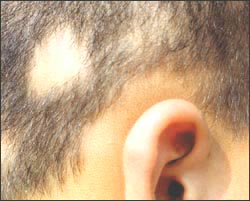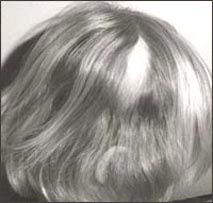원형 탈모증, Alopecia areata

사진 413. 특발성 원형 탈모증
Copyright ⓒ 2012 John Sangwon Lee, MD. FAAP

사진 414. 특발성 원형 탈모증
Copyright ⓒ 2012 John Sangwon Lee, MD. FAAP
원형 탈모증의 개요와 원인
- 두피나 피부에 염증도 없고 흉터도 생기지 않고 외상도 없으며 인설도 생기지 않는데 두발이나 체모가 원형으로 또는 타원형으로 갑자기 국소적으로 빠지는 증상 징후를 원형 탈모증이라 한다.
- 원인을 확실히 모른다.
- 특발성 탈모증이라고 한다.
- 원형 탈모증은 비교적 흔한 탈모증이다.
- 소아청소년 십만 명 중 17명에게 특발성 원형 탈모증이 있다.
- 원형 탈모증의 25~50%는 16세 이전에 생긴다.
- 원형 탈모증을 가진 아이들의 20%에서는 친부모 형제자매들에게도 원형 탈모증 병력이 과거나 현재 있고 원형 탈모증을 가진 사람들의 10%에서 자가면역 질환이 있으며 갑상선 질환이 있을 수 있다.
- 원형 탈모증은 어느 부위에 있는 피부에도 생길 수 있지만 주로 두피에 있는 두발에 더 흔히 생긴가.
- 연령에 관계없이 소아 청소년들이나 청년들에게 생길 수 있으나 25세 이하 연령층에 더 잘 생긴다.
- 친 형제 자매들에게도 생길 수 있는 확률은 10~20% 정도이다.
- 원형 탈모증 진행 경과는 다양하며 이 병이 발생된 지 3년 이내 85%에서 모발이 재생되는 것이 보통이다.
- 아토피 체질이 있는 아이들에게 생긴 원형 탈모의 정도가 더 심할 수 있고 증상 징후가 더 오래 갈 수 있으나 자가 면역 문제로 인해 생긴다고 추측한다.
- 원형 탈모증은 머리의 한군데나 여러 군데에 동시에 생길 수 있고 머리 전체에도 생길 수 있고 머리의 한군데 또는 여러 군데의 머리카락이 원형으로나 타원형으로 확실한 원인 없이 갑자기 빠지는 탈모증을 특발성 원형 탈모증이라고 한다.
- 머리의 대부분에서 머리털이 많이 빠져서 생긴 원형 탈모증을 전두 탈모증(온 머리 탈모증/Alopecia totalis)이라고 한다.
- 머리털 전부가 완전히 빠진 탈모증을 범 탈모증이라고 한다.
- 원형 탈모증이 있는 환자는 일반적으로 자가면역 질환이 생길 확률이 16%이고, 홍반성 낭창이 생길 가능성이 0.6%, 백반증이 생길 확률은 4%, 자가면역 갑상선 질환이 생길 가능성은 8 ~ 28%이다.
- John snagwon Lee syndrome으로도 원형성 탈모증이 생길일 수 있다.
원형 탈모증의 증상 징후
- 확실한 원인 없이 머리카락이 머리 일부에서 자연히 술술 빠질 수 있다.
- 탈모가 2~3주일 동안 계속되다가 더 이상 탈모되지 않는 상태로 계속 있을 수 있고 몇 개월 동안 조금씩 계속 머리가 빠질 수 있다.
- 머리카락만 빠질 수 있고, 머리카락과 눈썹이 동시 빠지는 경우도 있다.
- 드물게 전체의 머리카락이 전부 빠지기도 한다.
원형 탈모증의 진단
- 병력, 증상 징후와 진찰소견 등을 종합해서 이 병을 진단할 수 있다.
- 원형 탈모증은 두부백선(기계총), 모발 발거증(발모 광), 지루성 피부염성 탈모, 선천성 탈모증, 와위 압박성 탈모증 등과 감별 진단해야 한다.
원형 탈모증의 치료
- 특별한 치료법이 없다. 요즘은 Update, May 2022, Alopecia areata can be treated with baricitinit
- 특발성 원형 탈모증은 소아청소년과 전문의와 피부과 전문의로부터 치료를 받는 것이 보통이다.
- 머리털이 다시 날 때까지 기다려보든지 다음과 같이 약물 치료를 해본다.
- 탈모된 부위에 Triamcinolone 등 코르티코스테로이드제 주사로 치료를 해보든지 5% Minoxidil액을 원형 탈모가 있는 두피 환부에 바르고 국소적 코르티코스테로이드제 그림 등을 발라 치료하기도 한다.
- 그 외 Tar Preparations, Anthralin, Topical sensitizers, 또는 Ultraviolet light로 치료하기도 한다.
- 50% 이상 두발이 빠졌을 때는 국소적 Diphenylcyclopropenone 면역 치료를 하기도 한다.
- 정신 정서적 면에 문제가 있으면 임상 심리사나 정신과 전문의 치료를 받는다.
- 이렇게 치료해도 100% 완치되는 것은 장담할 수 없다.
Alopecia areata

Photo 413. Idiopathic alopecia areata Copyright ⓒ 2012 John Sangwon Lee, MD. FAAP

Photo 414. Idiopathic alopecia areata Copyright ⓒ 2012 John Sangwon Lee, MD. FAAP
Overview and Causes of Alopecia areata
• Alopecia areata is a symptom of sudden, localized loss of hair or body hair in a circular or oval shape, without inflammation, scarring, trauma, or scaling on the scalp or skin.
• The cause is not known for sure.
• This is called idiopathic alopecia.
• Alopecia areata is a relatively common type of alopecia.
• 17 out of 100,000 children and adolescents have idiopathic alopecia areata.
• 25-50% of alopecia areata occur before the age of 16.
• 20% of children with alopecia areata have a past or present history of alopecia areata even in their biological parents, and 10% of people with alopecia areata have autoimmune disease and may have thyroid disease.
• Alopecia areata can occur anywhere on the skin, but is it more common on the hair, mainly on the scalp.
• It can occur in children and adolescents of any age, but is more common in people younger than 25 years of age.
• There is a 10-20% chance that it can also happen to your own siblings.
• The course of alopecia areata varies, and it is common for hair to regenerate in 85% of cases within 3 years of onset.
• Alopecia areata in children with atopic constitution may be more severe and the symptoms may last longer, but we suspect it is due to an autoimmune problem.
• Alopecia areata can occur in one or several parts of the head at the same time, and it can also occur in the entire head. Alopecia areata in which one or several parts of the head suddenly falls out in a circular or oval shape without a definite cause is called idiopathic alopecia areata.
• Alopecia areata caused by the loss of a lot of hair on most of the head is called alopecia totalis (Alopecia totalis).
• Alopecia in which all hair is completely lost is called pan alopecia.
• Patients with alopecia areata generally have a 16% chance of developing an autoimmune disease, a 0.6% chance of developing lupus erythematosus, a 4% chance of developing vitiligo, and an 8 to 28% chance of developing autoimmune thyroid disease. to be.
• Alopecia areata can also occur with John sangwon Lee syndrome.
Symptoms, and signs of alopecia areata
• Hair may fall out naturally from part of the head without any obvious cause.
• Hair loss may continue for two to three weeks and then continue without hair loss and may continue to fall out little by little for several months.
• Only hair can fall out, and sometimes hair and eyebrows fall out at the same time.
• Rarely, the entire hair falls out completely.
Diagnosis of alopecia areata
• This disease can be diagnosed by synthesizing the medical history, symptom signs, and examination findings.
• Alopecia areata should be differentially diagnosed with ringworm of the head (machine gun), baldness of the hair, seborrheic dermatitis alopecia, congenital alopecia, and occipital pressure alopecia.
Treatment of alopecia areata
• Update, May 2022, Alopecia areata can be treated with baricitinit
• Idiopathic alopecia areata is usually treated by pediatricians and dermatologists.
• Wait for the hair to grow back or try medication as follows.
• Treat the bald area with a corticosteroid such as Triamcinolone, or apply 5% Minoxidil solution to the affected area of the scalp with alopecia areata, and apply a topical corticosteroid for treatment.
• Other treatments include Tar Preparations, Anthralin, Topical sensitizers, or Ultraviolet light.
• When more than 50% of hair loss occurs, topical Diphenylcyclopropenone immunotherapy is sometimes used.
• If you have psycho-emotional problems, see a clinical psychologist or psychiatrist.
• Even with this treatment, 100% cure cannot be guaranteed.
출처 및 참조 문헌
- www.drleepediatrics.com 제1권 소아청소년 응급 의료
- www.drleepediatrics.com 제2권 소아청소년 예방
- www.drleepediatrics.com 제3권 소아청소년 성장 발육 육아
- www.drleepediatrics.com 제4권 모유,모유수유, 이유
- www.drleepediatrics.com 제5권 인공영양, 우유, 이유식, 비타민, 미네랄, 단백질, 탄수화물, 지방
- www.drleepediatrics.com 제6권 신생아 성장 발육 육아 질병
- www.drleepediatrics.com제7권 소아청소년 감염병
- www.drleepediatrics.com제8권 소아청소년 호흡기 질환
- www.drleepediatrics.com제9권 소아청소년 소화기 질환
- www.drleepediatrics.com제10권. 소아청소년 신장 비뇨 생식기 질환
- www.drleepediatrics.com제11권. 소아청소년 심장 혈관계 질환
- www.drleepediatrics.com제12권. 소아청소년 신경 정신 질환, 행동 수면 문제
- www.drleepediatrics.com제13권. 소아청소년 혈액, 림프, 종양 질환
- www.drleepediatrics.com제14권. 소아청소년 내분비, 유전, 염색체, 대사, 희귀병
- www.drleepediatrics.com제15권. 소아청소년 알레르기, 자가 면역질환
- www.drleepediatrics.com제16권. 소아청소년 정형외과 질환
- www.drleepediatrics.com제17권. 소아청소년 피부 질환
- www.drleepediatrics.com제18권. 소아청소년 이비인후(귀 코 인두 후두) 질환
- www.drleepediatrics.com제19권. 소아청소년 안과 (눈)질환
- www.drleepediatrics.com 제20권 소아청소년 이 (치아)질환
- www.drleepediatrics.com 제21권 소아청소년 가정 학교 간호
- www.drleepediatrics.com 제22권 아들 딸 이렇게 사랑해 키우세요
- www.drleepediatrics.com 제23권 사춘기 아이들의 성장 발육 질병
- www.drleepediatrics.com 제24권 소아청소년 성교육
- www.drleepediatrics.com 제25권 임신, 분만, 출산, 신생아 돌보기
- Red book 29th-31st edition 2021
- Nelson Text Book of Pediatrics 19th- 21st Edition
- The Johns Hopkins Hospital, The Harriet Lane Handbook, 22nd edition
- 응급환자관리 정담미디어
- Pediatric Nutritional Handbook American Academy of Pediatrics
- 소아가정간호백과–부모도 반의사가 되어야 한다, 이상원 저
- The pregnancy Bible. By Joan stone, MD. Keith Eddleman, MD
- Neonatology Jeffrey J. Pomerance, C. Joan Richardson
- Preparation for Birth. Beverly Savage and Dianna Smith
- 임신에서 신생아 돌보기까지. 이상원
- Breastfeeding. by Ruth Lawrence and Robert Lawrence
- Sources and references on Growth, Development, Cares, and Diseases of Newborn Infants
- Emergency Medical Service for Children, By Ross Lab. May 1989. p.10
- Emergency care, Harvey Grant and Robert Murray
- Emergency Care Transportation of Sick and Injured American Academy of Orthopaedic Surgeons
- Emergency Pediatrics A Guide to Ambulatory Care, Roger M. Barkin, Peter Rosen
- Quick Reference To Pediatric Emergencies, Delmer J. Pascoe, M.D., Moses Grossman, M.D. with 26 contributors
- Neonatal resuscitation Ameican academy of pediatrics
- Pediatric Nutritional Handbook American Academy of Pediatrics
- Pediatric Resuscitation Pediatric Clinics of North America, Stephen M. Schexnayder, M.D.
-
Pediatric Critical Care, Pediatric Clinics of North America, James P. Orlowski, M.D.
-
Preparation for Birth. Beverly Savage and Dianna Smith
-
Infectious disease of children, Saul Krugman, Samuel L Katz, Ann A.
- 제4권 모유, 모유수유, 이유 참조문헌 및 출처
- 제5권 인공영양, 우유, 이유, 비타민, 단백질, 지방 탄수 화물 참조문헌 및 출처
- 제6권 신생아 성장발육 양호 질병 참조문헌 및 출처
- 소아과학 대한교과서
Copyright ⓒ 2014 John Sangwon Lee, MD, FAAP
“부모도 반의사가 되어야 한다”-내용은 여러분들의 의사로부터 얻은 정보와 진료를 대신할 수 없습니다.
“The information contained in this publication should not be used as a substitute for the medical care and advice of your doctor. There may be variations in treatment that your doctor may recommend based on individual facts and circumstances.
“Parental education is the best medicine.